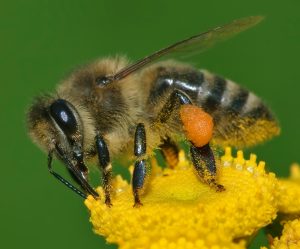“Rachel Carson’s (1962) analogy of a ‘chemical barrage being hurled against the fabric of life’ as a metaphor for the side effects of insecticides is still as relevant today as it was fifty years ago.”
“A lack of clear cut correlation between usage and effects has resulted in significant dispute, which has in turn stalled repeated efforts to shape up regulation, despite near unilateral agreement that there is a pressing need to work to improve the usage of neonicotinoids.”
.
Across much of the EU, consideration is being given to allow sugar beet farmers to use an insecticide banned two years ago:
Pesticides: EFSA to examine emergency use of neonicotinoids |
.
Today, the UK government has allowed the use of this highly controversial chemical:
UK allows emergency use of bee-harming pesticide – BBC News
.
The Scotsman lays out the reasons:
.
A pesticide that is ‘harmful to bees’ has been approved for use in the UK – here’s why
In answer to a letter from NFU members to Environment Secretary, George Eustice, urging for the need to use the neonicotinoid called Cruiser SB in England, government ministers agreed to the “limited and controlled” use of the pesticide for 120 days.
The UK has joined 11 countries, including Denmark, Belgium and Spain, and signed emergency authorisation for the pesticide’s use.
Chairman of the NFU sugar board, Michael Sly, said he was relieved the application was granted. He said: ”Any treatment will be used in a limited and controlled way on sugar beet, a non-flowering crop, and only when the scientific threshold has been independently judged to have been met. This authorisation is desperately needed to fight this disease. It will be crucial in ensuring that Britain’s sugar beet growers continue to have viable farm businesses.”
.
Pleas from environmentalists have not been taken on – with this recent piece from Turn Lyme Green:
.
THREAT TO BEES
ECO FILM-MAKER CALLS ON GOVERNMENT TO RESIST
POST-BREXIT LIFTING OF EU BAN ON BEE-KILLING PESTICIDES
Eco film-maker and organic farming champion, Robert Golden, is calling on the Government to resist a push by UK farmers for the lifting of a pesticide ban whichcould mean a “spring slaughter” of honeybees in order to grow more of one of the world’s most health-damaging foods, sugar. Mr Golden, from West Dorset, is also asking Sir David Attenborough and the Prime Minister’s fiancée, conservationist Carrie Symonds, to support a campaign for the Department of the Environment, Food and Rural Affairs [Defra] to reject any lobbying by the NFU, sugar beet farmers or sugar beet processor British Sugar for the EU ban on neonicotinoid pesticides to be lifted in post-Brexit Britain. The pesticides were prohibited under EU law because they contribute to the decline of honeybees and other crucial pollinators. Click here to read more about this threat.
.
 The campaign to ban these chemicals goes back a long way:
The campaign to ban these chemicals goes back a long way:
Futures Forum: Bees and pesticides: the research …. and the need for more research (2014)
Futures Forum: Bees and neonicotinoids >>> “Chemical companies pitch bug-killing options” (2017)
.
However, the science is actually not that clear:
Futures Forum: Bees and neonicotinoids > the latest research is ambiguous
.
Although how the chemical is applied does seem to make a big difference:
Neonicotinoids Barely Found in Pollen of Seed-treated Plants
When Is a Pesticide Not a Pesticide? When It Coats a Seed (1)
.
And alternatives might be more dangerous:
.
Alternatives to Neonicotinoids Could Be Even Worse for Honey Bees
Legislation reducing the use of neonicotinoids, notably in the EU and, more recently, in California, is generally viewed as a victory for pollinators like honey bees. However, some scientists worry that bans on neonicotinoids could cause farmers to turn to older and potentially more harmful insecticides instead.
The Washington Post reports that since the EU moratorium on the use of three key neonicotinoids went into effect in 2014, farmers in England have turned to pyrethroid pesticides, which are derived from two species of asters and are currently permitted in organic agriculture. Pyrethroid insecticides are reportedly low in toxicity to mammals and birds, but they are highly toxic to most insects including beneficial insects like honey bees…
Alternatives to Neonicotinoids Could Be Even Worse for Honey Bees – Organic Authority
.
Here, finally, is a measured response:
.
Saving British Wildlife: The Problems with Pesticides
Rachel Carson’s (1962) analogy of a ‘chemical barrage being hurled against the fabric of life’ as a metaphor for the side effects of insecticides is still as relevant today as it was fifty years ago in highlighting the seriousness of the effects of pesticides on pollinators.
A lack of clear cut correlation between usage and effects has resulted in significant dispute, which has in turn stalled repeated efforts to shape up regulation, despite near unilateral agreement that there is a pressing need to work to improve the usage of neonicotinoids (Alemmano, 2013).
Taking a comparative approach to the precautionary and sound science principles, this essay will argue that the best way to regulate this problem as a result, taking into consideration all stakeholders interests, is a compromised approach focused on proof, proportionality, value, certainties and precaution.
The complex nature of this issue means that neither a sound science or precautionary approach is equipped to take heed of the difficulties of regulating this issue given the gaps in data, the use of oversimplified risk assessments and the cost benefit burden of removing neonicotinoids from the market.
This essay will explore core fundamental themes of both principles (highlighted above): proof, proportionality, value, certainties and precaution.
Saving British Wildlife: The Problems with Pesticides — A COMMON EARTH
.
image: File: Apis mellifera Western honey bee.jpg – Wikimedia Commons